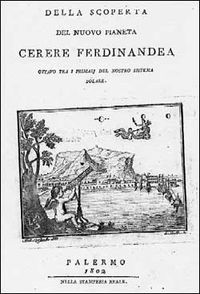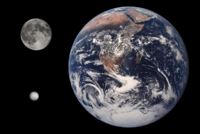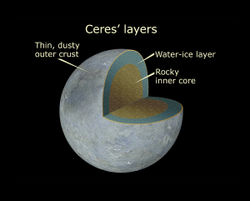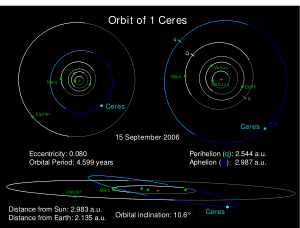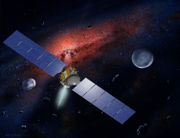Ceres (dwarf planet)
2008/9 Schools Wikipedia Selection. Related subjects: Space (Astronomy)
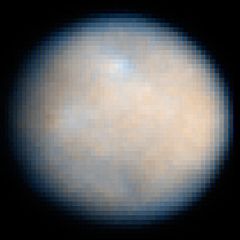 Ceres as seen by Hubble Space Telescope (ACS). The contrast has been enhanced to reveal surface details.
|
|||||||
|
Discovery
|
|||||||
|---|---|---|---|---|---|---|---|
| Discovered by | Giuseppe Piazzi | ||||||
| Discovery date | January 1, 1801 | ||||||
|
Designations
|
|||||||
| MPC designation | 1 Ceres | ||||||
| Alternate name | A899 OF; 1943 XB | ||||||
| Minor planet category |
dwarf planet main belt |
||||||
| Adjective | Cererian, Cerian | ||||||
|
Orbital characteristics
|
|||||||
| Epoch November 26, 2005 ( JD 2453700.5) |
|||||||
| Aphelion | 447,838,164 km 2.987 AU |
||||||
| Perihelion | 381,419,582 km 2.545 AU |
||||||
| Semi-major axis | 414,703,838 km 2.765 956 424 AU |
||||||
| Eccentricity | 0.07976017 | ||||||
| Orbital period | 1679.819 days 4.599 years |
||||||
| Average orbital speed | 17.882 km/s | ||||||
| Mean anomaly | 108.509° | ||||||
| Inclination | 10.586712° | ||||||
| Longitude of ascending node | 80.40696° | ||||||
| Argument of perihelion | 73.15073° | ||||||
|
Physical characteristics
|
|||||||
| Equatorial radius | 487.3 ± 1.8 km | ||||||
| Polar radius | 454.7 ± 1.6 km | ||||||
| Mass | 9.43 ± 0.07×1020 kg | ||||||
| Mean density | 2.077 ± 0.036 g/cm³ | ||||||
| Equatorial surface gravity | 0.27 m/s² 0.028 g |
||||||
| Escape velocity | 0.51 km/s | ||||||
| Sidereal rotation period |
0.3781 d 9.074170 h |
||||||
| Axial tilt | about 3° | ||||||
| North pole right ascension | 19 h 24 min 291° |
||||||
| North pole declination | 59° | ||||||
| Albedo | 0.090 ± 0.0033 ( V-band geometric) | ||||||
| Surface temp. Kelvin |
|
||||||
| Spectral type | C | ||||||
| Apparent magnitude | 6.7 to 9.32 | ||||||
| Absolute magnitude | 3.36 ± 0.02 | ||||||
| Angular diameter | 0.84" to 0.33" | ||||||
Ceres (pronounced /ˈsɪəriːz/, or as Latin: Cerēs), also designated 1 Ceres (see minor planet names), is the smallest identified dwarf planet in the Solar System and the only one in the asteroid belt. It was discovered on January 1, 1801, by Giuseppe Piazzi, and is named after the Roman goddess Ceres — the goddess of growing plants, the harvest, and of motherly love.
With a diameter of about 950 km, Ceres is by far the largest and most massive body in the asteroid belt, and contains approximately a third of the belt's total mass. Recent observations have revealed that it is spherical, unlike the irregular shapes of smaller bodies with lower gravity. The surface of Ceres is probably made of a mixture of water ice and various hydrated minerals like carbonates and clays. Ceres appears to be differentiated into a rocky core and ice mantle. It may harbour an ocean of liquid water, which makes it a target of current searches for extraterrestrial life. Ceres may be surrounded by a tenuous atmosphere containing water vapour.
Ceres' apparent magnitude ranges from 6.7 to 9.3, hence at its brightest is still too dim to be seen with the naked eye. On September 27, 2007, NASA launched the Dawn Mission space probe to explore Vesta (2011–2012) and Ceres (2015).
Discovery
The idea that an unknown planet could exist between the orbits of Mars and Jupiter was first suggested by Johann Elert Bode in 1768. His considerations were based on the so called Titius-Bode law, a now-abandoned theory which had been proposed by Johann Daniel Titius in 1766. According to this law the semi-major axis of the planet should be near 2.8 AU. William Herschel's discovery of Uranus in 1781 increased faith in the law of Titius and Bode, and in 1800, twenty-four experienced astronomers combined their efforts and began a methodical search for the proposed planet. The group was headed by Franz Xaver von Zach, editor of the Monatliche Correspondenz. While they did not discover Ceres, they later found several large asteroids.
Ceres was discovered on 1 January 1801, by Giuseppe Piazzi, who was searching for a star listed by Francis Wollaston as Mayer 87 because it was not in Mayer's zodiacal catalogue in the position given. Instead of a star, Piazzi found a moving star-like object, which he first thought was a comet. Piazzi observed Ceres a total of 24 times, the final time on February 11, when illness interrupted his observations. He announced his discovery on January 24, 1801 in letters to fellow astronomers, among them his compatriot Barnaba Oriani of Milan. He reported it as a comet but "since its movement is so slow and rather uniform, it has occurred to me several times that it might be something better than a comet". In April, Piazzi sent his complete observations to Oriani, Johann Elert Bode, and Jérôme Lalande in Paris. The information was published in the September 1801 issue of the Monatliche Correspondenz.
Soon after this, Ceres' apparent position had changed (mostly due to the Earth's orbital motion). It then appeared too close to the Sun's glare, so other astronomers could not confirm the observations of Piazzi until the end of the year. However after such a long time it was difficult to predict its exact position. To recover Ceres Carl Friedrich Gauss, then 24 years old, developed an efficient method of orbit determination. In only a few weeks, he predicted its path, and sent his results to von Zach. On 31 December 1801, von Zach and Heinrich W. M. Olbers found Ceres near the predicted position and thus recovered it.
In 1802 Herschel estimated Ceres to be 260 km in diameter, and in 1811 Johann Hieronymus Schröter estimated Ceres to be 2613 km in diameter.
Name
Piazzi originally suggested the name Ceres Ferdinandea ( Italian, Cerere Ferdinandea) for this body, after both the mythological figure Ceres (Roman goddess of plants) and King Ferdinand III of Sicily. "Ferdinandea" was not acceptable to other nations of the world and was thus dropped. Ceres was also called Hera for a short time in Germany. In Greece, it is called Δήμητρα ( Demeter), after the goddess Ceres' Greek equivalent; in English usage, Demeter is the name of an asteroid ( 1108 Demeter). Due to its uncommon usage, there is no consensus as to the proper adjectival form of the name, although the nonce forms Cerian and Cerean have been used in fiction. Grammatically, the form Cererean would be correct, derived from its Latin genitive, Cereris. Ceres' astronomical symbol is a sickle, (![]() ), similar to Venus' symbol (
), similar to Venus' symbol (![]() ) which is the female gender symbol and Venus' hand mirror. The element Cerium was named after Ceres. The element Palladium was originally also named after Ceres, but the discoverer changed its name after Cerium was named. Palladium is named after asteroid 2 Pallas.
) which is the female gender symbol and Venus' hand mirror. The element Cerium was named after Ceres. The element Palladium was originally also named after Ceres, but the discoverer changed its name after Cerium was named. Palladium is named after asteroid 2 Pallas.
Status
The classification of Ceres has changed more than once and has been the subject of some disagreement. Johann Elert Bode believed Ceres to be the "missing planet" he had proposed to exist between Mars and Jupiter, at a distance of 419 million km (2.8 AU) from the Sun. Ceres was assigned a planetary symbol, and remained listed as a planet in astronomy books and tables (along with 2 Pallas, 3 Juno and 4 Vesta) for about half a century until further asteroids were discovered.
However as other objects were discovered in the area it was realised that Ceres represented the first of a class of many similar bodies. Sir William Herschel coined in 1802 the term asteroid ("star-like") for such bodies, writing "they resemble small stars so much as hardly to be distinguished from them, even by very good telescopes". As the first such body to be discovered, it was given the designation 1 Ceres under the modern system of asteroid numbering.
The 2006 debate surrounding Pluto and what constitutes a 'planet' led to Ceres being considered for reclassification as a planet. A proposal before the International Astronomical Union for the definition of a planet would have defined a planet as "a celestial body that (a) has sufficient mass for its self-gravity to overcome rigid body forces so that it assumes a hydrostatic equilibrium (nearly round) shape, and (b) is in orbit around a star, and is neither a star nor a satellite of a planet". Had this resolution been adopted, it would have made Ceres the fifth planet in order from the Sun. However, it was not accepted, and in its place an alternate definition of "planet" came into effect as of August 24, 2006: A planet is "a celestial body that is in orbit around the sun, has sufficient mass for its self-gravity to overcome rigid body forces so that it assumes a ... nearly round shape, and has cleared the neighbourhood around its orbit." By this definition, Ceres is not a planet (because it shares its orbit with the thousands of other asteroids in the main asteroid belt), and is now classified as a " dwarf planet" (along with Pluto, Makemake and Eris). The issue of whether Ceres remains an asteroid was not addressed. Dual classifications such as Main-belt comets do exist, and being a dwarf planet does not preclude having dual designations.
Physical characteristics
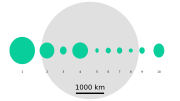
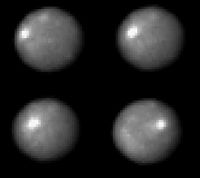
Ceres is the largest object in the asteroid belt, which lies between Mars and Jupiter. The Kuiper belt is known to contain larger objects, including Pluto, 50000 Quaoar, and 90482 Orcus, while more distant Eris, in the scattered disc, is the largest of all these bodies.
The mass of Ceres has been determined by analysis of the influence it exerts on small asteroids. Results obtained by different authors are slightly different. The average of the three most precise values as of 2008 is approximately 9.4×1020 kg. With this mass Ceres comprises about a third of the estimated total 3.0 ± 0.2 ×1021 kg mass of the asteroids in the solar system, together totalling about four percent of the mass of the Moon. Ceres' size and mass are sufficient to give it a nearly spherical shape. That is, it is close to hydrostatic equilibrium. In contrast, other large asteroids such as 2 Pallas, 3 Juno, and 4 Vesta are known to be quite irregular.
The surface composition of Ceres is broadly similar to that of C-type asteroids. However, some differences do exist. The ubiquitous features in the IR spectra of Ceres are that of hydrated materials, which indicates the presence of significant amounts of water in the interior of this body. Other possible surface constituents include iron-rich clays ( cronstedtite) and carbonates ( dolomite and siderite), which are common minerals in carbonaceous chondrite meteorites. The spectral features of carbonates and clay are usually absent in the spectra of other C-type asteroids. Sometimes Ceres is classified as G-type asteroid.
The surface of Ceres is relatively warm. The maximum temperature with the Sun overhead was estimated from measurements to be 235 K (about −38 ° C) on May 5, 1991. Taking into account also the heliocentric distance at the time, this gives an estimated maximum of about 239 K at perihelion. There are some indications that Ceres may have a tenuous atmosphere and water frost on the surface. Ultraviolet observations by IUE spacecraft detected statistically significant hydroxide water vapour near the Cererean north pole.
Peter Thomas of Cornell University has proposed that Ceres has a differentiated interior; its oblateness appears too small for an undifferentiated body, which indicates that it consists of a rocky core overlain with an icy mantle. This mantle of thickness from 120 to 60 km could contain 200 million cubic kilometres of water (16–26 percent of Ceres by mass; 30–60 percent by volume), which is more than the amount of fresh water on the Earth. This result is supported by the observations made by Keck telescope in 2002 and by evolutionary modelling.
Only a few features have been unambiguously detected on the surface of Ceres. High resolution ultraviolet Hubble Space Telescope images taken in 1995 showed a dark spot on its surface which was nicknamed "Piazzi" in honour of the discoverer of Ceres. This was thought to be a crater. Later near-infrared images with a higher resolution taken over a whole rotation with the Keck telescope using adaptive optics showed several bright and dark features moving with the dwarf planet's rotation. Two dark features had circular shapes and are presumably craters; one of them was observed to have a bright central region, while another was identifyied with "Piazzi" feature. More recent visible light Hubble Space Telescope images of a full rotation taken in 2003 and 2004 showed 11 recognizable surface features, the nature of which is currently unknown. One of these features corresponds to the "Piazzi" feature observed earlier.
These last observations also determined that Ceres' north pole points in the direction of right ascension 19 h 24 min (291°), declination +59°, in the constellation Draco. This means that Ceres' axial tilt is very small—about 3°.
Orbit
Ceres follows an orbit between Mars and Jupiter, within the main asteroid belt, with a period of 4.6 Earth years. The orbit is moderately inclined (i = 10.6° compared to 7° for Mercury and 17° for Pluto) and moderately eccentric (e = 0.08 compared to 0.09 for Mars).
The diagram illustrates the orbits of Ceres (blue) and several planets (white/grey). The segments of orbits below the ecliptic are plotted in darker colours, and the orange plus sign is the Sun's location. The top left diagram is a polar view that shows the location of Ceres in the gap between Mars and Jupiter. The top right is a close-up demonstrating the locations of the perihelia (q) and aphelia (Q) of Ceres and Mars. The perihelion of Mars is on the opposite side of the Sun from those of Ceres and several of the large main belt asteroids, including 2 Pallas and 10 Hygiea. The bottom diagram is a perspective view showing the inclination of the orbit of Ceres compared to the orbits of Mars and Jupiter.
In the past, Ceres had been considered to be the largest member of an asteroid family. These groupings of asteroids share similar orbital elements, which may indicate a common origin through an asteroid collision some time in the past. Ceres, however, was found to have spectral properties different from other members of the family, and so this grouping is now called the Gefion family, named after the lowest-numbered family member, 1272 Gefion. Ceres appears to be merely an interloper in its own family, coincidentally having similar orbital elements but not a common origin. Self rotation period of Ceres is 9 hours and 4 minutes.
Origin and evolution
The observations imply that Ceres is a remaining protoplanet – planetary embryo, which formed 4.57 billion years ago in the asteroid belt. While the majority of protoplanets (including all lunar- to Mars-sized bodies) were ejected from the Solar System by Jupiter or merged with other protoplanets to form terrestrial planets, Ceres survived relatively intact. Two other possible remaining protoplanets are Pallas and Vesta, but they do not have relaxed shapes, in the case of Vesta perhaps only because it suffered a catastrophic impact after solidifying.
Further evolution of Ceres was relatively simple. Heated by the energy of accretion and by decay of various radionuclides including, possibly, short-lived elements like Al26, Ceres differentiated into a rocky core and icy mantle soon after its formation. This event caused resurfacing by the water volcanism and tectonics erasing many geological features. However due to the fast depletion of heat sources Ceres cooled down quickly. The ice on the surface gradually sublimated leaving behind various hydrated minerals like clays and carbonates. Now Ceres is a geologically dead body, whose surface is being sculptured only by impacts.
The existence of significant amounts of water ice in Ceres raises a possibility that it has or had a layer of liquid water in the interior. This hypothetical layer is often called an ocean. The water layer is (or was) probably located between the rocky core and ice mantle like that in Europa. The existence of the ocean is more likely if ammonia or other antifreeze is dissolved in water. The possible existence of liquid water inside Ceres makes it a target in the search for extraterrestrial life.
Observations
When Ceres has an opposition near the perihelion, it can reach a visual magnitude of +6.7. This is generally regarded as being just barely too dim to be seen with the naked eye, but under exceptional viewing conditions a very sharp-sighted person may be able to see this dwarf planet. The only asteroids that can reach so bright a magnitude are 4 Vesta, and, during rare oppositions near perihelion, 2 Pallas and 7 Iris. At a conjunction Ceres has a magnitude of around +9.3, which corresponds to the faintest objects visible with 10×50 binoculars. It can thus be seen with binoculars whenever it is above the horizon of a fully dark sky.
Some notable observation milestones for Ceres include:
- An occultation of a star by Ceres observed in Mexico, Florida and across the Caribbean on November 13, 1984.
- Ultraviolet Hubble Space Telescope images with 50 km resolution taken in 1995.
- Infrared images with 30 km resolution taken with the Keck telescope in 2002 using adaptive optics.
- Visible light images with 30 km resolution (the best to date) taken using Hubble in 2003 and 2004.
Exploration
To date, no space probe has visited Ceres. However, NASA launched the Dawn Mission on 27 September 2007, which will explore the asteroid 4 Vesta in 2011 before arriving at Ceres in 2015.
The mission profile calls for the Dawn Spacecraft to enter orbit around Ceres at an altitude of 5,900 km. After five months of study, the spacecraft will reduce the orbital distance to 1,300 km, then down to 700 km after another five months. The spacecraft instrumentation includes a framing camera, a visual and infrared spectrometer, and a gamma-ray and neutron detector. These will be used to examine the dwarf planet's shape and element abundance.
Radio signals from spacecraft in orbit around Mars and on its surface have been used to estimate the mass of Ceres from the perturbations induced by it onto the motion of Mars.
